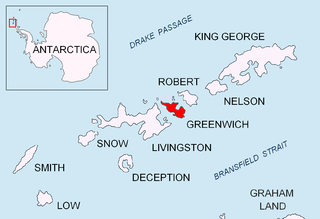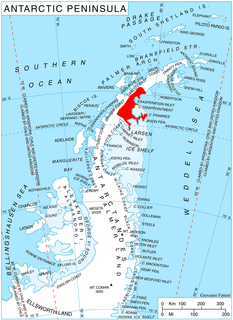The French Antarctic Expedition is any of several French expeditions in Antarctica.

Quito Glacier is a glacier draining the northeast slopes of Mount Plymouth and flowing northeastwards into the sea west of Canto Point in north Greenwich Island, South Shetland Islands. It was named after the capital of Ecuador, c. 1990, by the Ecuadorian Antarctic Expedition.
Aerodromnaya Hill is an isolated rock hill standing 1 mile (2 km) south of the Schirmacher Hills in Queen Maud Land. The hill was discovered and first roughly mapped from air photos by the German Antarctic Expedition, 1938–39. It was named Gora Aerodromnaya by the Soviet Antarctic Expedition, 1961, because a landing strip was established in the vicinity in connection with nearby Novolazarevskaya Station.

Laws Glacier is a confluent glacier system which flows into Marshall Bay on the south coast of Coronation Island, in the South Orkney Islands off Antarctica. It was surveyed in 1948–49 by the Falkland Islands Dependencies Survey (FIDS), and was named by the UK Antarctic Place-Names Committee for Richard M. Laws of the FIDS, leader and biologist at Signy Research Station in 1948 and 1949, and at South Georgia in 1951.

Flask Glacier, is a gently-sloping glacier, 25 nautical miles long, flowing east from Bruce Plateau to enter Scar Inlet between Daggoo Peak and Spouter Peak in Graham Land, Antarctica. The lower reaches of this glacier were surveyed and photographed by the Falklands Islands Dependencies Survey (FIDS) in 1947. The entire glacier was photographed by the Falkland Islands and Dependencies Aerial Survey Expedition in 1955–56, and mapped by the FIDS in 1957. It was named by the UK Antarctic Place-names Committee after the third mate on the Pequod in Herman Melville's Moby-Dick; or, The White Whale.
Wold Nunatak is a nunatak standing 10 nautical miles (18 km) east of Mount Manthe in the southeast part of the Hudson Mountains. Mapped by United States Geological Survey (USGS) from surveys and U.S. Navy air photos, 1960-66. Named by Advisory Committee on Antarctic Names (US-ACAN) for Richard J. Wold, United States Antarctic Research Program (USARP) geologist at Byrd Station, 1960-61 season.

Aphrodite Glacier is a glacier 15 nautical miles (28 km) long flowing north to the east coast of the Antarctic Peninsula 3 nautical miles (6 km) west of Victory Nunatak. The lower portion of the feature was first plotted by W.L.G. Joerg from aerial photographs taken by Sir Hubert Wilkins in December 1928 and by Lincoln Ellsworth in November 1935. The glacier was subsequently photographed by the Ronne Antarctic Research Expedition in December 1947 and surveyed by the Falkland Islands Dependencies Survey in December 1958 and November 1960. It was named by the UK Antarctic Place-Names Committee after Aphrodite, the goddess of love in Greek mythology.

Blades Glacier is a glacier flowing east from the snow-covered saddle just north of La Gorce Peak, Alexandra Mountains. It merges with Dalton Glacier on the north side of Edward VII Peninsula. It was mapped by the United States Geological Survey from surveys and from U.S. Navy air photos, 1959–65, and named by the Advisory Committee on Antarctic Names for William Robert Blades who served as navigator during U.S. Navy Operation Highjump (1946–47) and Operation Deep Freeze (1955–59).

Cadman Glacier is a glacier, 1.5 nautical miles (3 km) wide at its mouth and about 7 nautical miles (13 km) long, flowing northwestward into the head of the southern arm of Beascochea Bay south of Plas Point on the west side of the Antarctic Peninsula.

Chavez Island is an island 3 nautical miles (6 km) long which rises to 550 metres (1,800 ft), lying immediately west of Magnier Peninsula, which is between Leroux Bay and Bigo Bay, off the west coast of Graham Land. It was discovered and named by the French Antarctic Expedition, 1908–10, under Jean-Baptiste Charcot, probably for Commandant Alfonso Chaves of Ponta Delgada, Azores, but the spelling Chavez has become established through long usage.
Otlet Glacier is a glacier 9 nautical miles (17 km) long, flowing along the south side of Fontaine Heights to the west coast of Graham Land. Roughly charted by the British Graham Land Expedition (BGLE) under Rymill, 1934-37. More accurately mapped by the Falkland Islands Dependencies Survey (FIDS) from photos taken by Hunting Aerosurveys Ltd. in 1956-57. Named by the United Kingdom Antarctic Place-Names Committee (UK-APC) for Paul Otlet (1868–1944), Belgian documentalist, co-founder of the Institut International de Bibliographie at Brussels, 1895, and of the Universal Decimal Classification. He was a pioneer of the rational organization of polar information by an international classification scheme.
Jinks Island is an island lying 5 nautical miles (9 km) north of Pickwick Island, in the Pitt Islands of the Biscoe Islands, Antarctica. Shown on an Argentine government chart of 1957, it was named by the UK Antarctic Place-Names Committee in 1959 after Mr. Jinks, a character in Charles Dickens' The Pickwick Papers.
Planet Heights is a series of summits running along an ice-free ridge, extending 24 nautical miles (44 km) in a north-south direction between the southernmost extremity of the LeMay Range and George VI Sound in the east part of Alexander Island, Antarctica. Many landforms and nearby features are named in association with this mountain range, some of these include landforms named after astronomers, satellites, planets and other things related to astrology and astrophysics. The mountain range was first mapped from air photos taken by the Ronne Antarctic Research Expedition (RARE), 1947–48, by Searle of the Falkland Islands Dependencies Survey (FIDS) in 1960. Named by the United Kingdom Antarctic Place-Names Committee (UK-APC) from association with the nearby glaciers named for planets of the solar system. The only planet that is not featured in any of these glaciers is the planet Earth, as there are no glaciers named "Earth Glacier" and this glacier does not exist.

Pickwick Island is the largest of the Pitt Islands, in the Biscoe Islands, Antarctica. It is 9.45 km long in southwest-northeast direction, separated from Renaud Island on the southwest by Mraka Sound, and has its northeast coast indented by Misionis Bay.
Fingeren Peak is a peak immediately northwest of Hogskavlpiggen Peak, in the Borg Massif of Queen Maud Land, Antarctica. It was mapped by Norwegian cartographers from surveys and air photos by the Norwegian–British–Swedish Antarctic Expedition (1949–52) and named Fingeren.
Grayson Nunatak is a nunatak situated 3 nautical miles (6 km) west of Crummey Nunatak in Antarctica. It is the northwesternmost feature of the Gutenko Nunataks, in the Ford Ranges of Marie Byrd Land. The nunatak was discovered and first mapped by the United States Antarctic Service, 1939–41. It was remapped by the United States Geological Survey from surveys and U.S. Navy aerial photography, 1959–65, and was named by the Advisory Committee on Antarctic Names for Donald E. Grayson, an engineer at Byrd Station, 1970.
Migmatitovaya Rock is a rock at the eastern end of a spur, lying 3 nautical miles (6 km) northeast of Terletskiy Peak in the Shcherbakov Range of the Orvin Mountains, Queen Maud Land, Antarctica. It was roughly plotted from air photos by the Third German Antarctic Expedition, 1938–39, and was mapped from air photos and surveys by the Sixth Norwegian Antarctic Expedition, 1956–60. The feature was remapped by the Soviet Antarctic Expedition, 1960–61, and named "Skala Migmatitovaya".

Starbuck Glacier is a glacier 15 nautical miles (28 km) long, flowing east along the south side of Taridin Ridge and Padesh Ridge, and entering Scar Inlet immediately north of Mount Queequeg, on the east coast of Graham Land. Surveyed and partially photographed by the Falkland Islands Dependencies Survey (FIDS) in 1947. The entire glacier was photographed by the Falkland Islands and Dependencies Aerial Survey Expedition (FIDASE) in 1955-56, and mapped from these photos by the FIDS in 1957. Named by the United Kingdom Antarctic Place-Names Committee (UK-APC) after the first mate on the Pequod in Herman Melville's Moby-Dick.
Thomsen Islands is a group of small islands lying 2 nautical miles (3.7 km) southwest of Speerschneider Point, off the west side of Renaud Island in the Biscoe Islands. First accurately shown on an Argentine government chart of 1957. Named by the United Kingdom Antarctic Place-Names Committee (UK-APC) in 1959 for Helge Thomsen, Danish meteorologist, who, for a number of years beginning in 1946, was responsible for editing Dansk Meteorologisk Institut's annual reports on the state of the sea ice in the Arctic.











